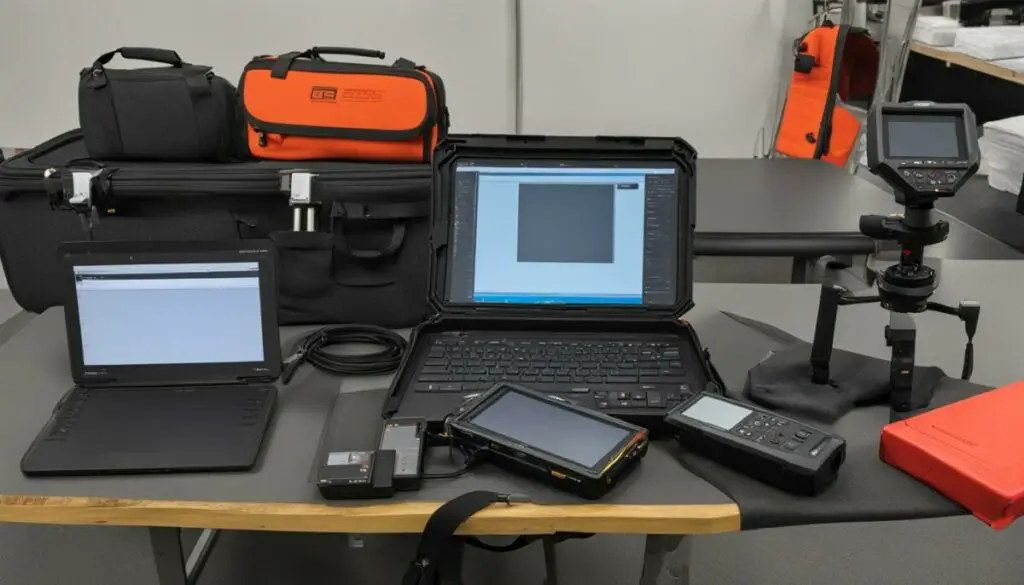Last Updated on 5 months by Francis
Infrared cameras, also known as thermal imaging cameras, are valuable tools for home inspectors. They can detect potential issues that may be hidden from the naked eye, such as water leaks and heat/cold infiltration. Infrared cameras use thermal imaging technology to translate heat signatures into colors, allowing inspectors to identify areas of concern. These cameras are particularly useful for identifying water leaks, as they can detect the cool signatures of moisture. Overall, infrared cameras provide a non-invasive and effective method for conducting home inspections.
Contents
Key Takeaways:
- Infrared cameras are valuable tools for home inspectors.
- They can detect hidden issues such as water leaks and heat/cold infiltration.
- Thermal imaging technology translates heat signatures into colors.
- Infrared cameras are particularly useful for identifying water leaks.
- They provide a non-invasive and effective method for conducting home inspections.
What is a Thermal Imaging Home Inspection?

A thermal imaging home inspection involves the use of a thermal imaging camera to detect potential issues in a property’s foundation, walls, attics, or other hard-to-see spaces. These inspections utilize thermal imaging technology to capture heat signatures and translate them into visual images that can be analyzed by home inspectors. By detecting variations in temperature, thermal imaging cameras can identify potential problem areas that may require further investigation.
During a thermal imaging home inspection, the inspector passes the camera over various surfaces to produce thermal images. These images help identify differences in temperature that may indicate issues such as water leaks, insulation problems, or electrical hotspots. The thermal images provide valuable insights into the condition of the property and can help guide the inspector in assessing potential risks or areas in need of repair.
Thermal imaging home inspections offer several advantages over traditional visual inspections. They provide a non-invasive method of detecting hidden issues without the need for destructive testing or invasive measures. Additionally, these inspections can be conducted quickly and efficiently, allowing for a thorough assessment of the property’s condition. By utilizing thermal imaging technology, home inspectors can offer a more comprehensive evaluation to clients, ensuring that potential issues are identified and addressed.
Benefits of Thermal Imaging Home Inspections:
- Non-invasive detection of hidden issues
- Quick and efficient inspections
- Comprehensive evaluation of property condition
How Does an Infrared Thermography Inspection Work?

An infrared thermography inspection utilizes a specialized tool known as a thermal imaging camera to assess the condition of a property. This camera is designed to detect and capture the thermal energy emitted by objects and translate it into a visible image. By scanning the interior and exterior surfaces of a property, the camera creates a thermal image that displays temperature variations in different colors, allowing the inspector to identify potential problem areas.
During the inspection process, the home inspector carefully scans each surface with the thermal imaging camera. As the camera passes over a particular area, it captures the temperature signatures of different objects and materials. These temperature readings are then translated into colors on the thermal image, creating a visual representation of the temperature distribution within the property.
The inspector can then analyze the thermal image to identify areas that deviate from the expected temperature range. This can include areas of heat loss, moisture intrusion, electrical issues, and other potential problems. By using the thermal imaging camera, the inspector can detect issues that may not be visible to the naked eye and provide valuable insights into the overall condition of the property.
Benefits of an Infrared Thermography Inspection:
- Non-invasive: An infrared thermography inspection does not require any physical contact with the property and can be conducted without causing any damage.
- Efficient: The use of a thermal imaging camera allows for a quick and comprehensive inspection, saving time and providing accurate results.
- Early Detection: By identifying potential issues at an early stage, such as moisture intrusion or electrical problems, infrared thermography inspections can help prevent costly repairs in the future.
| Issue | Traditional Inspection | Infrared Thermography Inspection |
|---|---|---|
| Moisture Intrusion | Visible signs, invasive tests | Identifies cool signatures of moisture |
| Electrical Problems | Visual inspection | Detects potential hot spots |
| Insulation Deficiencies | Visual inspection, invasive tests | Identifies areas of heat loss |
Using thermal imaging technology, an infrared thermography inspection provides valuable insights into a property’s condition, allowing potential issues to be identified early on. By utilizing a thermal imaging camera, inspectors can detect heat signatures, moisture intrusion, electrical problems, and insulation deficiencies that may not be visible to the naked eye. This non-invasive and efficient inspection method offers numerous benefits, making it a valuable tool for home inspections.
Differences Between Infrared Home Inspections and Regular Home Inspections

An infrared home inspection differs from a regular home inspection in several key ways. While regular inspections focus on visually inspecting a property, infrared inspections utilize thermal imaging technology to detect potential issues that may not be visible to the naked eye. Here are some of the main differences between the two:
- Visualization: Regular home inspections rely on visual cues to identify problems, while infrared inspections use thermal imaging to detect heat signatures. This allows infrared inspectors to identify areas of concern that may not be visible, such as hidden water leaks or insulation issues.
- Non-Invasive: Traditional inspections often involve physically accessing areas of the property for a closer look. Infrared inspections, on the other hand, are non-invasive and do not require any dismantling or opening of walls. This makes them less disruptive and preserves the integrity of the property.
- Comprehensive Analysis: Infrared inspections provide an additional layer of analysis by detecting heat signatures. This allows inspectors to identify potential problems before they become major issues, such as energy inefficiencies or electrical hotspots. Regular inspections may not have the same level of detail in these areas.
Infrared home inspections offer a more thorough and comprehensive assessment of a property’s condition compared to regular inspections. By harnessing the power of thermal imaging technology, inspectors can uncover hidden issues and provide valuable insights to homeowners or potential buyers.
Overall, while regular home inspections serve their purpose in evaluating the general condition of a property, infrared home inspections offer a more in-depth analysis. By incorporating thermal imaging technology, infrared inspections can identify potential problems that may go unnoticed in a traditional inspection. This makes them an invaluable tool for homeowners and property buyers who want a comprehensive assessment of a property’s condition.
What are 3 Benefits of Using Thermal Imaging for Home Inspections?

Infrared cameras offer several advantages for home inspections, making them a valuable tool for both inspectors and homeowners. Here are three key benefits of using thermal imaging technology:
- Early detection of water leaks: One of the primary benefits of infrared cameras is their ability to identify potential water leaks. By detecting the cool signatures of moisture, these cameras can locate hidden leaks before they become major issues. This early detection can help prevent costly water damage and the need for extensive repairs.
- Non-invasive inspection method: Unlike traditional inspection methods that may require invasive measures like opening walls or removing flooring, thermal imaging provides a non-invasive solution. Inspectors can simply scan the surfaces of a property using the infrared camera, capturing temperature variations that may indicate underlying issues.
- Efficient and time-saving: Thermal imaging inspections are quick and easy, allowing for a thorough assessment of a property in just a few hours. This efficiency is beneficial for both inspectors and clients, as it minimizes disruption and allows inspections to be conducted promptly. Additionally, thermal imaging eliminates the need for buyers or sellers to be present during the inspection, providing added convenience.
With these benefits in mind, it’s clear that infrared cameras provide valuable insights into a property’s condition, allowing for more informed decisions and proactive maintenance.
Quotes:
“Infrared cameras are a game-changer for home inspections. They allow us to see beyond what the naked eye can detect, helping us uncover hidden issues and potential problems early on.” – John Smith, Certified Home Inspector
3 Types of Devices Used in Infrared Inspections

Infrared inspections utilize various devices to provide accurate results. The primary device used is the thermal imaging camera, which uses infrared technology to create thermal images or heat signatures. This camera can detect thermal energy emitted by objects and translate it into a visible image. Another device commonly used is the spot radiometer, which measures the thermal energy emitted by an object in a specific area and provides a temperature reading. Lastly, the thermal line scanner measures the radiant temperature along a given line, allowing for quick identification of insulation issues or potential hot spots.
“The thermal imaging camera allows us to see heat signatures that are invisible to the naked eye. It’s like having superpowers to detect issues that may be hidden from plain sight,” says John Smith, a certified infrared inspector.
Table 1: Comparison of Devices Used in Infrared Inspections
| Device | Function | Key Features |
|---|---|---|
| Thermal Imaging Camera | Create thermal images | Detects thermal energy emitted by objects |
| Spot Radiometer | Measures thermal energy in specific areas | Provides temperature readings |
| Thermal Line Scanner | Measures radiant temperature along a line | Identifies insulation issues and hot spots |
Good Practices for Infrared Inspectors: 3 Useful Tips to Successfully Conduct a Thermal Inspection
When conducting a thermal inspection, infrared inspectors should follow certain best practices to ensure accurate and successful results. Here are three useful tips for conducting a thermal inspection:
- Prioritize client safety: Safety should always be a top priority during a thermal inspection. Inspectors should take the necessary precautions and ensure that the client understands any potential safety hazards. This may include wearing appropriate personal protective equipment and following safety guidelines when working in certain environments.
- Maintain a strong understanding of the technology: Infrared inspectors should have a deep understanding of the thermal imaging technology they are using. This includes understanding its limitations and potential sources of error. By familiarizing themselves with the equipment and its capabilities, inspectors can accurately interpret the thermal images and identify potential problem areas.
- Communicate effectively with the client: Effective communication is essential during a thermal inspection. Inspectors should take the time to explain the process to the client, including how the thermal imaging technology works and what they are looking for. Additionally, inspectors should address any concerns or questions the client may have, helping them feel confident in the inspection process.
By following these good practices, infrared inspectors can conduct thorough and successful thermal inspections, providing clients with valuable insights into the condition of their property.
Image source: https://seowriting.ai/32_6.png
Understanding the History and Applications of Infrared Cameras
Infrared cameras have a fascinating history dating back to their discovery by William Herschel in 1800. Originally used for military reconnaissance, the development of infrared technology eventually led to its widespread application in commercial and industrial settings. Over time, infrared cameras have become an essential tool in building inspections, offering a more accurate and comprehensive way to identify defects compared to traditional methods.
Today, infrared cameras are extensively used in various industries to detect and document a wide range of issues. In building inspections, these cameras can locate and assess problems like moisture intrusion, heat loss, air leakage, and electrical faults. By translating thermal energy into visible images, infrared cameras provide valuable insights that help inspectors make informed decisions and prevent costly repairs.
The advancement of thermal imaging technology has revolutionized the way inspections are conducted. Infrared cameras offer a non-invasive approach, allowing inspectors to analyze a property without causing damage. Moreover, the ability to detect hidden defects and anomalies makes infrared cameras a valuable tool for property buyers, sellers, and inspectors alike.
The Applications of Infrared Cameras
The applications of infrared cameras extend far beyond building inspections. They are widely used in the fields of medicine, manufacturing, agriculture, and security. In the medical industry, infrared cameras can aid in diagnosing and monitoring various conditions, such as vascular diseases, arthritis, and cancer. In manufacturing, these cameras play a crucial role in quality control, ensuring that products meet specific thermal requirements. In agriculture, infrared cameras help detect crop diseases, optimize irrigation, and monitor livestock health. Additionally, in the security sector, infrared cameras are used for surveillance and night vision purposes.
With their rich history and diverse applications, infrared cameras continue to evolve and improve. As technology advances, these cameras will likely become even more precise, versatile, and affordable, opening up new possibilities in the realm of inspections and beyond.
Conclusion
Infrared cameras are an invaluable tool for home inspections, providing a range of benefits and advantages. These cameras have the ability to detect potential issues that may be hidden from the naked eye, such as water leaks and heat/cold infiltration. By using thermal imaging technology, infrared cameras translate heat signatures into colors, allowing inspectors to identify areas of concern.
One of the key advantages of infrared cameras is their non-invasive nature, as they do not require any demolition or opening of walls. This makes them a convenient and efficient method for conducting home inspections. Additionally, thermal imaging is quick and easy, allowing inspections to be completed in just a few hours without the need for the buyer or seller to be present.
Overall, infrared cameras provide an additional layer of analysis to regular home inspections by detecting heat signatures and identifying potential problem areas. They serve as a valuable tool for both home buyers and sellers, providing peace of mind and helping to prevent costly repairs down the line.
FAQ
Are infrared cameras helpful for home inspections or not?
Yes, infrared cameras, also known as thermal imaging cameras, are valuable tools for home inspections. They can detect potential issues that may be hidden from the naked eye, such as water leaks and heat/cold infiltration.
What is a thermal imaging home inspection?
A thermal imaging home inspection involves using a thermal imaging camera to detect potential issues in a property’s foundation, walls, attics, or other hard-to-see spaces. The camera can see in the infrared spectrum and detect warm and cold heat signatures.
How does an infrared thermography inspection work?
An infrared thermography inspection works by using a thermal imaging camera to scan the interior and exterior surfaces of a property. The camera detects temperature signatures and translates them into various colors on the thermal image, helping identify potential problem areas.
How are infrared home inspections different from regular home inspections?
Infrared home inspections are different from regular home inspections in that they incorporate thermal imaging technology. Regular home inspections focus on visually inspecting the overall conditions of a property, while infrared inspections use thermal imaging to detect potential hidden issues.
What are 3 benefits of using thermal imaging for home inspections?
Firstly, thermal imaging helps identify potential water leaks early on. Secondly, it is a non-invasive inspection method that does not require any demolition. Thirdly, it is quick and easy, allowing the inspection to be conducted in a few hours without the need for the buyer or seller to be present.
What are the 3 types of devices used in infrared inspections?
The primary device used is the thermal imaging camera. Another device commonly used is the spot radiometer, and the thermal line scanner is used for quick identification of insulation issues or potential hot spots.
What are some good practices for infrared inspectors to successfully conduct a thermal inspection?
Firstly, prioritize client safety by taking necessary precautions. Secondly, maintain a strong understanding of the technology and its limitations. Thirdly, communicate effectively with the client, explaining the process and addressing any concerns they may have.
What is the history and applications of infrared cameras?
Infrared cameras have a rich history, starting with their discovery by William Herschel in 1800. They were initially used for military reconnaissance and later expanded into commercial and industrial applications. They have become popular in building inspections and are essential tools for inspectors in various industries.
Conclusion
Infrared cameras are highly beneficial for home inspections, providing a non-invasive and efficient method for identifying hidden issues. They help detect water leaks, heat/cold infiltration, and other problems. By following best practices, infrared inspectors can conduct thorough and accurate inspections, providing peace of mind to home buyers and sellers.









